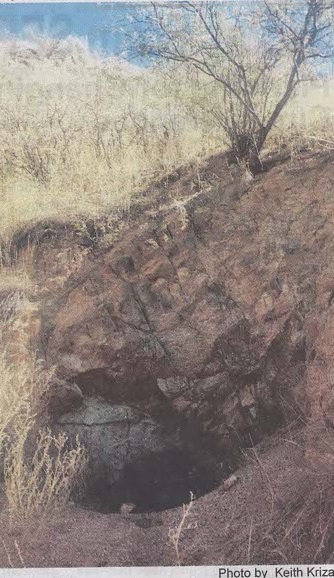
|
|
|
Mines Menu:
Mines Map
Use the links at the left to return.
|
|
Mine Report |
|
Billy D Mine | |
Mining District and MinesPalmetto District - west slope of Patagonia Mountains between Sonoita Creek to the north and Canada de la Paloma to the south1 A former underground Au-Ag-Pb-Zn-Cu-Mo mine located in the center of sec. 11, T23S, R15E, on National Forest land. Owned by Mr. Captain Max Ritterrath (1946)2. Locationcenter of sec. 11, T23S, R15E2 Mineral ProductsAg, Au, Pb, Zn 5 GeologyUnknown.1 Type of Operation and Production
Photos
Progress and the Demise of the Billie DBy Keith Krizan (therealkbkkbk@gmail.com) in the Patagonia Regional Times, November 2024.
The Oxford English Dictionary defines progress as: Advancement to a further or higher stage ... usually to better state, improvement. But one man's progress may be another's downfall. Just look at the Billie D mine near Patagonia. The Billie D is a former gold mine that sits on an unnamed hill in the Palmetto Mining district in the Patagonia Mountains. Its last owner of record was a former rancher from Mesa named Max Ritterrath. Arizona mining, was, for at least several generations, a mostly small, Mom and Pop type of operation. Even the mining camps that first formed around the mineral strikes, and then grew to become the boom towns with stamp mills and post offices resembled nothing so much as a floating craps game with players and characters moving from place to place as the richest and easiest to extract materials gave way to thinner ores. All the while, worldwide production was soaring. In 1850, 50,000 tons of copper were produced. In forty years, that number had increased to 500,000 tons. In 1930 annual copper output was over 2,000,000 tons. Gold followed a similar trajectory going from 20 - 25 tons per year in 1848, to 920 tons by 1930. Mining went through enormous changes during this period. In 1867 Alfred Noble, a Swedish chemist and engineer, invented dynamite. Minerals could be blasted and mucked out of mines quicker than could be done with pickaxe and shovel. Obtaining minerals went from being a labor-intensive enterprise to being a capital-intensive enterprise. Mom and Pop were about to get the boot. Progress? When economic activity slowed and the Great Depression set in, many of the smaller mines were beneficiaries of Federal Government help via the Reconstruction Finance Corporation Act of 1931. Founded by President Herbert Hoover, it effectively served as the discount lending window of the Federal Reserve Board. Between 1932 and 1957 it provided financial support to state and local governmenets and made loans to, among other businesses, mines. The Mining Journal for August 30, 1937 announced that Max Ritterath had been approved for a $20,000 loan for his mine in Santa Cruz County, Arizona. The money was used to construct a crossover tunnel between two existing shafts, but it failed to uncover a hoped-for new vein of ore. Progress? By 1939 Ritterrath was desperately seeking new capital for the Billie D. A potential source was George M. Church of Fort Worth, TX. Church was a oil-man and not adverse to taking risks for unseen rewards in the earth. Hopes for this deal were squashed, howver, at an October 1939, meeting in Nogales when a mi ing engineer hired by Church, delivered a pessimostic report on the mine. The meeting was over in five mintes and church was on his way. Progress? Ritterrath then turned to California attorney, Gordon F. Crokhite, who represented potential investors. J. S. Coupal, director of the Department of Mineral Resources (DMR) was pressed upon by the Californai attorney to produce another, definitive engineer's report on the mine. Promises of bringing investment dollars to Arizona and even by Ritterrath to relocate his home back to Arizona, were made in exchange for a favorable report. Miles M. Carpenter, who worked for Coupal at the DMR, was taksed with making the report. Ritterrath was anxious for approval. Money was waiting in the wings. But the field engineer's disappointing report of May 10, 1940, sounded the death knell for the Billie D. The last we hear from Ritterrath is in a 1946 mine owner's report where he was shown planning for the future of the mine, stating that a "mill will be installed to reduce ore for shipping." On line 17 of the report he wrote of the Billie D, "Not for Sale. I use my own Capital."
References
|
 5
5
